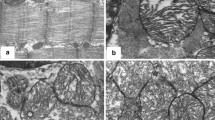The role of KATP channels in myocardial infarct size-limiting effect of chronic continuous normobaric hypoxia was examined in a rat model based on a 20-min coronary occlusion and subsequent 3-h reperfusion. Rats were adapted to normobaric hypoxia (12% O2) for 21 days. This hypoxia produced a pronounced infarct size-limiting effect, which had been prevented by 0.3 mg/kg glibenclamide, a non-selective inhibitor of entire pool of KATP channels, or 5 mg/kg 5-hydroxydecanoate, an inhibitor of mitochondrial KATP channels. The study highlighted the important role of mitochondrial KATP channels in myocardial infarct size-limiting effect of chronic normobaric hypoxia.
Similar content being viewed by others
References
Naryzhnaya NV, Maslov LN, Prokudina ES, Lishmanov YB. Contribution of opioid receptors to the cytoprotective effect of the adaptation to chronic hypoxia at anoxia/reoxygenation of isolated cardiomyocytes. Bull. Exp. Biol. Med. 2015;159(2):209-212.
Naryzhnaya NV, Maslov LN, Tsibulnikov SYu, Prokudina ES, Lishmanov YuB. Involvement of no-synthase in the infarct reducing effect of continuous chronic normobaric hypoxia. Ros. Fiziol. Zh. 2015;101(8):921-928. Russian.
Naryzhnaya NV, Nackar Ya, Maslov LN, Lishmanov YuB, Kolar F, Lasukova TV. The role of sarcolemmal and mitochondrial KATP-channels in realization of the cardioprotection and antiarrhythmic effect of different regimens of hypobaric adaptation. Ros. Fiziol. Zh. 2009;95(8):837-849. Russian.
Costa AD, Garlid KD, West IC, Lincoln TM, Downey JM, Cohen MV, Critz SD. Protein kinase G transmits the cardioprotective signal from cytosol to mitochondria. Circ. Res. 2005;97(4):329-336.
Costa AD, Garlid KD. Intramitochondrial signaling: interactions among mitoKATP, PKCepsilon, ROS, and MPT. Am. J. Physiol. Heart Circ. Physiol. 2008;295(2):H874-H882.
Costa AD, Pierre SV, Cohen MV, Downey JM, Garlid KD. cGMP signalling in pre- and post-conditioning: the role of mitochondria. Cardiovasc. Res. 2008;77(2):344-352.
Halestrap AP, Richardson AP. The mitochondrial permeability transition: a current perspective on its identity and role in ischaemia/reperfusion injury. J. Mol. Cell. Cardiol. 2015;78):129-141.
Holzerová K, Hlaváčková M, Žurmanová J, Borchert G, Neckář J, Kolář F, Novák F, Nováková O. Involvement of PKCepsilon in cardioprotection induced by adaptation to chronic continuous hypoxia. Physiol. Res. 2015;64(2):191-201.
Maslov LN, Naryzhnaya NV, Prokudina ES, Kolar F, Gorbunov AS, Zhang Y, Wang H, Tsibulnikov SY, Portnichenko AG, Lasukova TV, Lishmanov YB. Preserved cardiac mitochondrial function and reduced ischaemia/reperfusion injury afforded by chronic continuous hypoxia: role of opioid receptors. Clin. Exp. Pharmacol. Physiol. 2015;42(5):496-501.
Maslov LN, Naryzhnaia NV, Tsibulnikov SY, Kolar F, Zhang Y, Wang H, Gusakova AM, Lishmanov YB. Role of endogenous opioid peptides in the infarct size-limiting effect of adaptation to chronic continuous hypoxia. Life Sci. 2013;93(9-11):373-379.
Neckár J, Marková I, Novák F, Nováková O, Szárszoi O, Ost’ádal B, Kolár F. Increased expression and altered subcellular distribution of PKC-delta in chronically hypoxic rat myocardium: involvement in cardioprotection. Am. J. Physiol. Heart Circ. Physiol. 2005;288(4):H1566-H1572.
Penna CM. Perrelli G, Pagliaro P. Mitochondrial pathways, permeability transition pore, and redox signaling in cardioprotection: therapeutic implications. Antioxid. Redox Signal. 2013;18(5):556-599.
Schultz JE. Yao Z, Cavero I, Gross GJ. Glibenclamide-induced blockade of ischemic preconditioning is time dependent in intact rat heart. Am. J. Physiol. 1997;272(6, Pt 2):H2607-H2615.
Yellon DM, Downey JM. Preconditioning the myocardium: from cellular physiology to clinical cardiology. Physiol. Rev. 2003;83(4):1113-1151.
Author information
Authors and Affiliations
Corresponding author
Additional information
Translated from Byulleten’ Eksperimental’noi Biologii i Meditsiny, Vol. 163, No. 1, pp. 28-31, January, 2017
Rights and permissions
About this article
Cite this article
Lishmanov, Y.B., Naryzhnaya, N.V., Tsibul’nikov, S.Y. et al. Role of ATP-Sensitive K+ Channels in Myocardial Infarct Size-Limiting Effect of Chronic Continuous Normobaric Hypoxia. Bull Exp Biol Med 163, 22–24 (2017). https://doi.org/10.1007/s10517-017-3728-8
Received:
Published:
Issue Date:
DOI: https://doi.org/10.1007/s10517-017-3728-8




